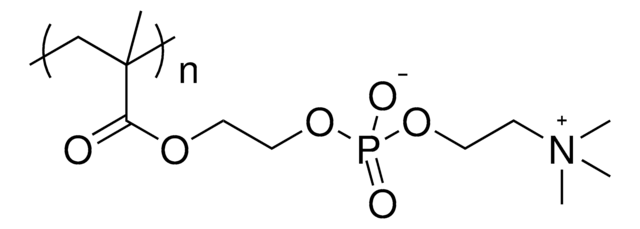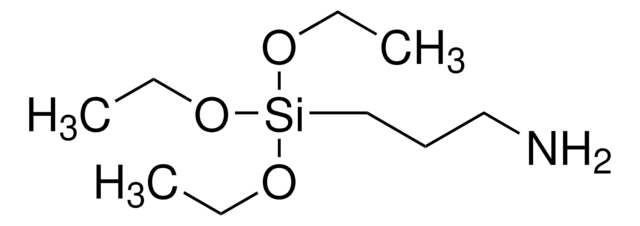925640
Poly (ethylene glycol)-block-Poly (sulfobetaine methacrylate)
PEG average Mn 5000, PSBMA Mn 13,000
Synonym(s):
PEG-PDMAPS, PEG-PSBMA, PSBMA, Poly (sulfobetaine methacrylate)
Sign Into View Organizational & Contract Pricing
All Photos(1)
About This Item
Linear Formula:
CH3(C2H4O)nC6H7O2N(C11H21O5NS)mOH
UNSPSC Code:
12352112
NACRES:
NA.23
Recommended Products
mol wt
PEG average Mn 5000
PSBMA Mn 13,000
Quality Level
Related Categories
Application
Biocompatible, non-fouling block copolymer composed of a neutral PEG block and a zwitterionic poly(sulfobetaine methacrylate) (PSBMA) block.
Poly(sulfobetaine methacrylate) (PSBMA) is a well-known zwitterionic polymer, it is non-toxic and biocompatible. On each of its repeating unit, it carries both a positive charge and a negative charge, leading to its strong hydration capacity.
Surfaces coated with PSBMA showed super hydrophilic property and strong resistance to protein adsorption/bacterial adhesion, making this polymer a promising material in anti-fouling applications.
Poly(sulfobetaine methacrylate) (PSBMA) is a well-known zwitterionic polymer, it is non-toxic and biocompatible. On each of its repeating unit, it carries both a positive charge and a negative charge, leading to its strong hydration capacity.
Surfaces coated with PSBMA showed super hydrophilic property and strong resistance to protein adsorption/bacterial adhesion, making this polymer a promising material in anti-fouling applications.
Storage Class Code
11 - Combustible Solids
WGK
WGK 3
Flash Point(F)
Not applicable
Flash Point(C)
Not applicable
Choose from one of the most recent versions:
Certificates of Analysis (COA)
Lot/Batch Number
Don't see the Right Version?
If you require a particular version, you can look up a specific certificate by the Lot or Batch number.
Already Own This Product?
Find documentation for the products that you have recently purchased in the Document Library.
Jiang Wu et al.
Acta biomaterialia, 40, 172-181 (2016-05-05)
Nonfouling materials such as neutral poly(ethylene glycol) (PEG) and zwitterionic poly(sulfobetaine methacrylate) (pSBMA) are ideal biocompatible materials for drug, especially protein drug delivery. The interaction behavior of protein between the nonfouling materials could cause great impact on their future applications
Se Yeong Lee et al.
Biomaterials research, 22, 3-3 (2018-02-17)
Zwitterionic molecules have been widely studied as coating materials for preparing anti-fouling surfaces because they possess strong hydration properties that can resist non-specific protein adsorption. Numerous studies on surface modification using zwitterionic molecules have been investigated, such as electrochemically mediated
Our team of scientists has experience in all areas of research including Life Science, Material Science, Chemical Synthesis, Chromatography, Analytical and many others.
Contact Technical Service![[2-(Methacryloyloxy)ethyl]dimethyl-(3-sulfopropyl)ammonium hydroxide 95%](/deepweb/assets/sigmaaldrich/product/structures/217/219/73c91e1c-0ee4-4b3d-bead-a6dc3d09d1da/640/73c91e1c-0ee4-4b3d-bead-a6dc3d09d1da.png)







![[3-(2-Aminoethylamino)propyl]trimethoxysilane technical grade, ≥80%](/deepweb/assets/sigmaaldrich/product/structures/149/508/f87a9a89-f138-4c5e-9fe0-6561914241c3/640/f87a9a89-f138-4c5e-9fe0-6561914241c3.png)